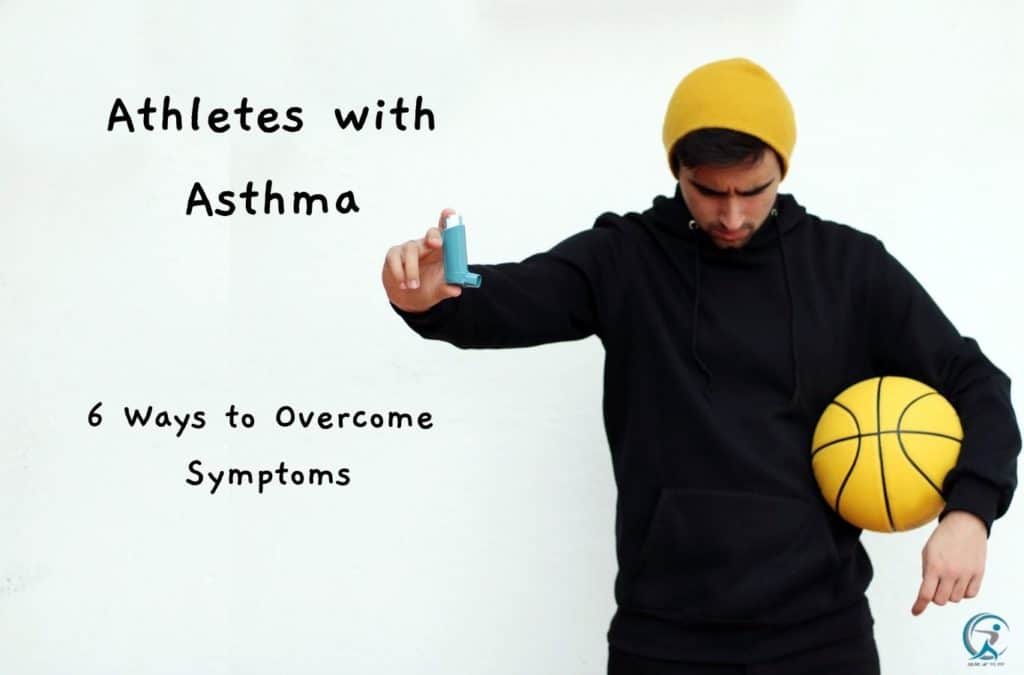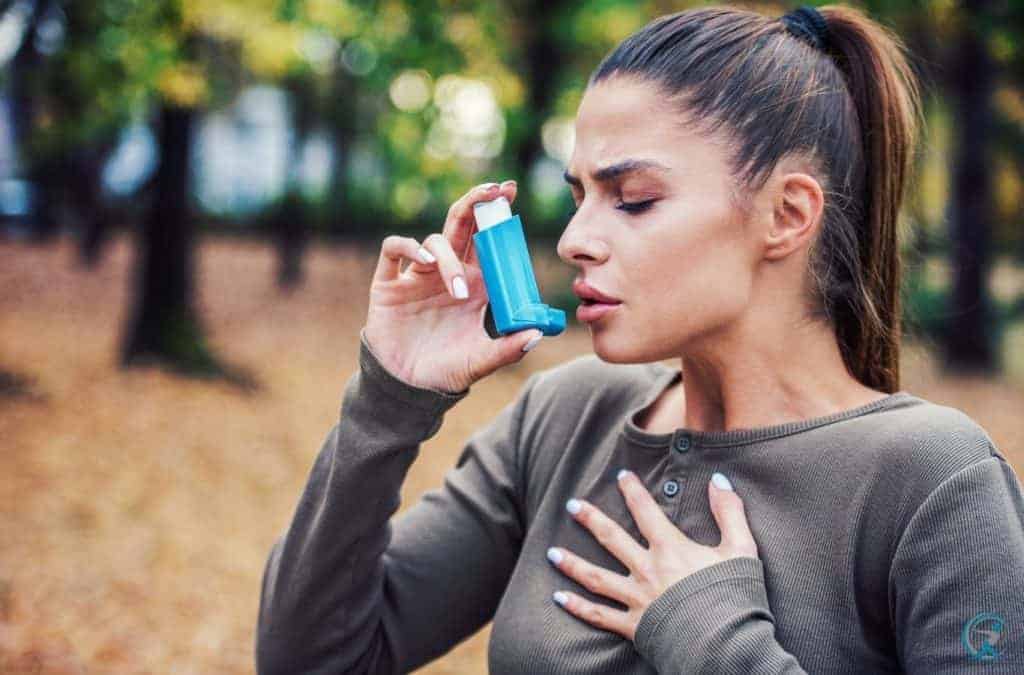
Asthma is a common health concern caused due to intermittent narrowing of the airways in the lungs and decreased measure of airflow. This leads to severe symptoms, such as wheezing, coughing, dyspnea, shortness of breath, chest tightness, etc., which begin around 5-20 minutes after starting exercise, and in some cases, immediately after stopping physical activity.
Also called exercise-induced bronchoconstriction (EIB) or exercise-induced asthma, it is triggered by a physical workout. Even athletes who do not have asthma can suffer from EIB due to frequent and intense exercise. Its signs and symptoms are:
- Nonasthmatic inspiratory wheeze
- Vocal cord dysfunction and
- Cardiac arrhythmias,
- Coughing & Wheezing
- Shortness of breath
- Fatigue during exercise
- Poorer than expected athletic performance
- Avoidance of activity (a sign primarily among young children)
Understandably, athletes with asthma get hesitant to run and restrict themselves from regular physical activities. If you are facing the same challenges, then don’t let them hold you back. Exercise-induced asthma may not have any specific cure but its symptoms are manageable.
Key Takeaways
- Athletes with asthma can still excel in their sports, despite the challenges of the condition.
- Regular exercise can play a crucial role in managing asthma symptoms, improving lung capacity and overall endurance.
- It’s vital for athletes with asthma to have a well-managed asthma action plan, including knowing when to use their inhaler and recognizing triggers.
- Certain sports like swimming may be more asthma-friendly due to warm, humid environments.
- Regular communication with healthcare providers is essential for athletes with asthma to ensure optimal performance and health.
- Asthma shouldn’t limit athletic potential; numerous professional athletes have succeeded despite their asthma.
Ways Athletes Can Manage Asthma Symptoms

Take Preventive Measures
Before you start a workout, create an action plan with the help of your doctor. This will ensure that you take all preventive measures to control common triggers of asthma without hampering your exercise routine. Use an inhaler for long-term management to soothe airway inflammation. This will mitigate the risks of flare-ups. Also, you can use a rescue inhaler that contains medicines to open the airways. Don’t forget to ask your doctor about emergency actions in case you forget to take an inhaler and get an asthma attack.
Use Proper Asthma Medications
Visit your doctor to get a prescription and take timely medications. Usually, athletes use a short-acting beta-2 agonist, such as albuterol, with two inhalations at least 15 to 20 minutes before starting their workout. This prevents airway spasms for several hours and ensures proper exercise without any hurdles. A long-acting bronchodilator is effective for 12 hours but is not recommended as a monotherapy. Doctors also suggest long-term inhaled anti-inflammatory medications to “quiet” the airways.
Always Carry an Inhaler
To manage asthma and its symptoms, use an asthma inhaler with a beta-agonist bronchodilator (salbutamol or terbutaline). If you experience any symptoms while running, take a rescue inhaler without delay to prevent the attack. This has been an effective measure in about 80% of EIB patients. Working as a preventive therapy, an inhaler should be taken 15 minutes before exercise, and it works for 4-6 hours. Make sure to add a reminder so that you never forget to carry your inhaler.
Exercise More
Your overall health is crucial to overcoming exercise-induced asthma as it directly correlates with obesity. So, the more your work out, the better shape you are in, and the fewer asthma symptoms you experience. A regular exercise regime improves the emotional and physical well-being of people, including EIB patients. So, participate in sports activities and sweat it out more but keep your inhaler with you always.
Don’t Skip Warm-ups and Cool-downs
A 10-minute warm-up and cool-down exercise is not only a good habit but an essential step to adjust airways. This becomes even more important if you are leaving/entering a heated or air-conditioned room because any drastic change in body temperature can lead to signs and symptoms of exercise-induced bronchoconstriction.
Try Swimming
As swimming is done in a warm and humid environment, it doesn’t allow airways to dry. Hence, making it a good option for exercise-induced asthma patients. However, indoor pools have irritants in the air that can aggravate symptoms so be careful. Moreover, you can try other sports, such as gymnastics, golf, volleyball, and baseball that require short bursts of activity and are less likely to trigger symptoms.
When to See a Doctor
Despite asthma, you can run safely. However, in case of severe symptoms of exercise-induced bronchoconstriction, visit your doctor immediately for a prompt and accurate diagnosis. Get instant medical treatment if you experience:
- The rapid increase in wheezing or shortness of breath.
- No improvement in asthma symptoms after using an inhaler.
Latest Research-Backed Data
- Exercise and asthma: an overview – PMC
- Date Published: Nov 3, 2015
- Summary: The article discusses data from recent Olympic Games showing that asthmatic athletes have achieved high levels of success. It also delves into the hypothesis supported by studies on occupational asthma.
- Link to the article
- Self-reported asthma and allergies in top athletes compared to the …
- Date Published: Nov 30, 2010
- Summary: This research compares self-reported asthma and allergies in top athletes to the general population. It mentions the variability in prevalence based on the methods used and the athletes included in the study.
- Link to the article
- National Athletic Trainers’ Association Position Statement …
- Date Published: Not specified
- Summary: Based on current research and literature, the National Athletic Trainers’ Association provides a position statement on the management of asthma in athletes.
- Link to the article
- Exercise-induced asthma – Symptoms & causes – Mayo Clinic
- Date Published: Not specified
- Summary: The article from Mayo Clinic provides insights into the symptoms and causes of exercise-induced asthma, which is a common condition among athletes.
- Link to the article
- What Is Exercise-Induced Asthma? | AAFA.org
- Date Published: Not specified
- Summary: The Asthma and Allergy Foundation of America (AAFA) discusses exercise-induced asthma, highlighting its symptoms and emphasizing that exercise is a common cause of asthma symptoms.
- Link to the article
These articles provide insights into the challenges faced by athletes with asthma, the prevalence of asthma among top athletes, and the management and understanding of exercise-induced asthma.
FAQs
Can athletes have asthma?
Yes, athletes can have asthma. Many successful athletes manage their asthma effectively and excel in their sports.
How does exercise affect asthma?
Exercise can trigger asthma symptoms in some people. However, with proper management, exercise can improve lung function and overall health.
What sports are best for people with asthma?
Swimming, cycling, and walking are often recommended for people with asthma as they are less likely to trigger symptoms.
Can asthma medication affect athletic performance?
Most asthma medications do not enhance performance. They simply allow athletes with asthma to perform at their best.
Can training improve asthma in athletes?
Regular training, when combined with appropriate medication, can help athletes manage their asthma effectively.
Conclusion
So, let’s catch our breath for a moment and circle back to what we’ve learned about our audacious [athletes with asthma]. Their stories are far from the wheezy tales you might expect. From winning Olympic gold to breaking world records, these athletes have shown that an asthma diagnosis is not a barrier to success in the sports world, but rather a hurdle they’ve managed to leap over with grace.
Despite the challenges, these athletes have turned the tables on asthma, refusing to be confined by their condition. They’ve taken control, managing their symptoms, and reaching for the stars. Or, in this case, for the finish line.
In essence, their journey is a testament to human resilience and determination. It is a reminder that limitations can often be self-imposed and that with perseverance and the right treatment regimen, even a respiratory condition like asthma can be managed effectively.
So, whether you’re an aspiring athlete or a seasoned pro dealing with asthma, remember this: Your condition doesn’t define you – your grit does. So strap on those running shoes, grab your inhaler and show the world what [athletes with asthma] are made of! If you found this article insightful, why not breathe easy and share it with others who could benefit? After all, sharing is caring. Now, go out there and conquer your world, one breath at a time!
Author Bio:
Krishma Patel is the Co-founder and the Superintendent Pharmacist at MedsNow, an online pharmacy in the UK that provides health and wellness products and treatments along with free online consultations. She is passionate about showcasing the integral function community pharmacies can play in supporting the healthcare system and the NHS by providing patients with high quality, safe and discreet access to healthcare at their convenience. Along with being the co-founder of MedsNow, Krishma is also the Director and the Superintendent Pharmacist of Enimed Ltd., an independent pharmacy group comprising 32 branches.
As a veteran fitness technology innovator and the founder of GearUpToFit.com, Alex Papaioannou stands at the intersection of health science and artificial intelligence. With over a decade of specialized experience in digital wellness solutions, he’s transforming how people approach their fitness journey through data-driven methodologies.